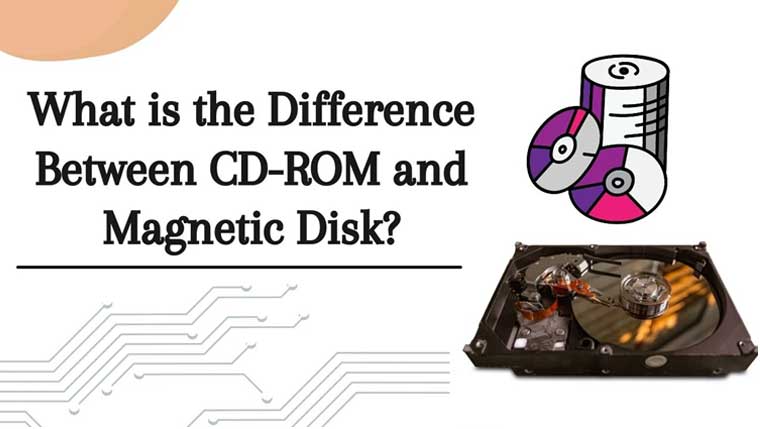Optical disks use a thin layer of metal or alloy to record the data. When the recording is made, this thin layer of metal is heated to a high temperature and rotated before being cooled down. The thin heated coating is then encased in a plastic case to protect it from damage and prevent fragments from getting into the disk drive. Metal types include aluminum and gold. CD-ROMs encase less information than magnetic disks, which have been around since 1956. The sliding nature of the disk allows data to be read and written more than once, so disks often feature more than one of each. The addition of sides allow data to be spread out across the discs. Optical disks are often made not only to store information, but also to play it.
Table of Contents
Difference Between CD ROM and Magnetic Disk
A CD-ROM, or Compact Disc Random Access Memory, is a storage device with a compact disc of polymer coated with iron oxide. The magnetic disk operates through a head actuator to read and write data on a disc of nickel metal alloy. CD rotation velocity is 1000 nan seconds, or 150 kilo rotations per minute, while that of a 100 megabyte hard drive is 8.33 nan seconds, or 225 kilos/minute. Computer forensics used the magnetic disk of the hard drive of the criminal’s computer as evidence against him .
History of CD-ROM
CD-ROM stands for CD-read only memory. It was the successor to the floppy disk and was designed specifically for playback of audio and video multimedia items. CD-ROMs were a significant improvement in storage capacity due to their digital, rather than analog, format.
Origin of Magnetic Disks
Originally, magnetic disks stored millions of bytes for each read/write operation. This technology matured and users were able to store billions of bytes per disk. The problem with this technology is that it’s difficult to read data from a magnetic disk because it’s too large and spinning very quickly. To avoid such problems, the production speed of a magnetic disk is designed to run at a certain velocity and magnetic heads used on it can read data very fast. If more data needs to be read from a magnetic disk, the production speed of the magnetic disk needs to be increased and the read/write operation on it takes longer time . To overcome this problem, additional buffer memory is provided for slow magnetic disk. Now each read/write operation takes a long time but the user will not perceive slower running of programs on a slow magnetic disk since it will be running slow as it is composed of cylinders and tracks containing small clusters .
How Data is Written on a CD ROM vs. Magnetic Disk
CD-ROMs write data to a special coating on the disk. This is done by a laser that scans across the disk in a spiral pattern which gathers billions of bumps of data at a time. The bumps are read with a concave, gold coated metal piece called an “optical pickup head.”
Computer disks, on the other hand, use tiny areas called “tracks” which are made by setting up minute magnetic fields on the surface of the recording medium. The tiny, magnetic particles align themselves to the magnetic fields and create tiny areas surrounded by more still particles.
Impact on Memory Cell Size
CD-ROMs and magnetic disks store digital media with a different precision. CD-ROMs use pits and bumps like normal CDs with the digits 0 and 1. Magnetic disks store data by aligning little chunks of metal on your hard drive in specific orientation; little bumps represent 1s and flat spots represent 0s. Both technologies work with binary numbers and thus can both store lots of information. The difference is the amount of space each technology uses on the storage medium: pits and bumps are much smaller than the spaces between magnetic chunks. That means that 3 1/2-inch floppy disks can only store 128MB.
Common Mistakes on the Difference Between CD’s
One way to spot a CD-ROM and a magnetic disk is by looking at their labels. If it’s labeled with “CD” or “CD-Rom”, it is the former; if not, it is usually labelled as “Magnetic Disk”.
The other way is to check for the holes. A CD-ROM always has two small holes on either side of the disk, whereas a magnetic disk has one. Note that the size of the holes is not given. CD’s are able to be played more than once, while most disk-based media typically can ‘t be. Make sure to check for this if you still don’t know what type of media you have or your application wants you to write to CD ‘s.
Conclusion
A CD-ROM disk is used to store data that are less likely to change, such as applications, videos or sound files. When you are looking for a reliable disk that can disclose all of your data automatically while you aren’t using your computer or while it’s turned off, you will need a magnetic hard disk.

